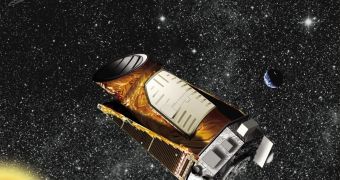The future of the Kepler space satellite, which has been looking for alien planets for the past few years (quite successfully, too), is in peril as another reaction wheel has malfunctioned.
The satellite now only has two working wheels out of four. It needs three to be able to position itself.
One wheel malfunctioned last year, but the telescope could operate with the remaining three. A few months ago, another wheel started showing signs of trouble indicating an imminent failure.
Now, the latest data seen by NASA suggests that this wheel is gone as well. This triggered the telescope to go into safe mode.
NASA engineers are now working on placing the telescope in a fixed position which would minimize fuel usage and still provide a direct communication link.
Without the reaction wheels, which are powered by the solar panels, the telescope has to burn fuel to align itself properly.
Kepler's mission is to detect exoplanets by looking at minute variations in the light coming from some 150,000 stars. The light dims as planets pass in front of the stars. It's looking at all those stars all the time, which is why it needs to be kept pointing at the exact same portion of the sky.
Because of its orbit around the sun, it needs constant adjustments. NASA scientists are now trying to figure out if there is any way for Kepler to continue its mission without the reaction wheels.
If placed in a static Point Rest State position, its fuel supply would last for several more years, but it couldn't continue its operations properly.
Scientists are trying to figure out if they can maneuver the telescope using the two remaining wheels and the thrusters or if they can revive the malfunctioning wheel. No decision to end data collection has been made at this point.

 14 DAY TRIAL //
14 DAY TRIAL //